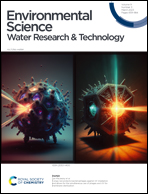Preparation and application of carboxylated and mechanically attrited carbon for adsorptive removal of crystal violet dye
Abstract
The effectiveness of carboxylated activated carbon (CAC), prepared using an organochlorine compound and sodium hydroxide under wet milling condition, was tested as an adsorbent for the removal of cationic dye crystal violet (CV). The adsorption phenomena was characterized using BET, XRD, ESEM, XEDS, FTIR and HR-TEM studies. The equilibrium adsorption capacity for the CV dye onto CAC was achieved in as early as 30 min. A study of isotherms accompanied with error analysis showed that the experimental data fit well with the Langmuir isotherm with a maximum adsorption capacity of 255.8 mg g−1. The adsorption process was endothermic with a higher dye removal rate at increased temperature. Analysis of the mass transfer parameters revealed that intraparticle diffusion and film diffusion both played their part, whereas other kinetic studies have shown that the experimental data fit best with the pseudo 2nd order rate. The activation energy (Ea = 44.53 kJ mol−1) suggested that the process was controlled by chemisorption. A regeneration study on the used CAC showed that the adsorption capacity decreased from 94.5% to 49.7% at the 6th cycle. The results inferred that CAC can be employed as an economical and efficient adsorbent for the treatment of industrial wastewater including dyes.



 Please wait while we load your content...
Please wait while we load your content...